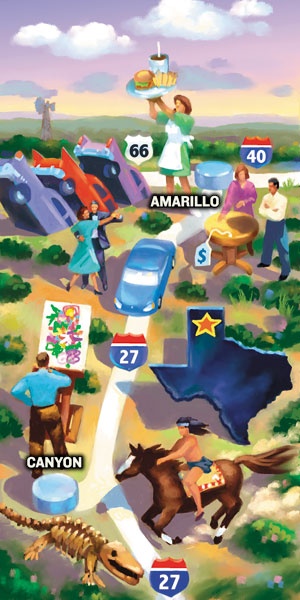Up in the Panhandle, where flat land abruptly gives way to ancient, rugged canyons, it’s easy to imagine dinosaurs digging their claws into the earth millions of years ago.
Those dinosaurs vanished long ago, but some of their bones are on magnificent display at the Panhandle-Plains Historical Museum in Canyon.
Just outside Amarillo, I studied the bones of modern-day dinosaurs—vintage tail-finned cars—at Cadillac Ranch. And within city limits, I strolled the skeleton of the legendary Route 66 in a historic district designed to bring the road and its commerce back to life.
Our trip starts in the Route 66 district and then heads 3 miles west of Amarillo on Interstate 40 to Cadillac Ranch (the cars are just south of the interstate on the eastbound side). Next, we travel 15 miles south on Interstate 27 and U.S. 87 to Canyon to visit Texas’ largest history museum.
Amarillo
Born in 1926, Route 66 symbolized freedom and mobility on the open road.
Ultimately, Route 66 was replaced by bigger interstates, such as I-40 that roars through Amarillo. But the city’s historic district, the heart of which is a 15-block section on Southwest Sixth Avenue between Georgia and Western streets, is trying to pull in tourists and business. Business owners believe that their eclectic mix of antique stores and others—not to mention the allure of Route 66 itself—is sufficiently attractive.
Some of the district’s buildings are listed on the National Register of Historical Places.
One such building, the Nat, which houses a gigantic used bookstore and ballroom, originally was an open-air natatorium built in 1922. The reportedly haunted building was enclosed in 1923 and later converted to a dance hall with 10,000 square feet of maple flooring covering the pool area.
The highlight for me was supper at the Golden Light Cafe, which opened in 1946. I spent $7.58 on a burger, soft drink and not-so-small basket of fries. Now that’s a price from yesteryear.
Route 66 district, 1-866-645-0666, www.amarillo66.com
Cadillac Ranch
Out in a wide-open pasture, the wind whipped my pants legs and mournfully whistled through the bodies of 10 old Cadillacs, their noses buried in the ground and tail fins stuck in the air. Mesmerized, I could hear Bruce Springsteen’s “Cadillac Ranch” in my head:
Cadillac, Cadillac
Long and dark, shiny and black
Open up them engines let ’em roar
Tearing up the highway like a big
old dinosaur.
These Cadillacs—which, with every inch covered in colorful graffiti, resemble spray-painted Easter eggs—no longer roar down the road. But their appeal is so strong that travelers wielding cameras and spray-paint cans pull off the interstate every few minutes to check them out.
Stanley Marsh 3, who dreamed up Cadillac Ranch 34 years ago, said the cars represent the period from 1948 through 1964 when Cadillac put tail fins on its vehicles.
It’s all about art, Marsh said, noting that the tail fins cut the horizon just beyond the barbed-wire fence and spray-painted iron gate that visitors swing open to walk to the cars.
“I think that art on the High Plains, where it’s flat, should look different from art in a forest or the mountains or the beach,” he said.
Canyon
Here’s my advice for anyone visiting the Panhandle-Plains Historical Museum: Give yourself a whole day. Or two.
With 2 million artifacts, 102,004 square feet of total exhibit space, 33,095 photographs, 300 works of art available for viewing at any time and 15 permanent collections that include ranching and Native American life, transportation, firearms, windmills, geology and a replica of a pioneer town—just to throw out a few numbers—the museum simply can’t be savored on a quick walk-through.
The museum’s collections range from the strange—a large autograph collection includes a lock of George Washington’s hair—to the bigger than life: Among many impressive findings, the paleontology exhibit boasts one particularly scary-looking specimen, a labyrinthodont amphibian. The large aquatic animal sported a medial third eye on its flat, bony skull.
The museum’s art galleries alone are worth the trip and, among several high-profile artists, feature the works of Frank Reaugh (1860-1945), known as the dean of Texas painters.
Panhandle-Plains Historical Museum, (806) 651-2244, www.panhandleplains.org
——————–
Camille Wheeler is the staff writer for Texas Co-op Power.


